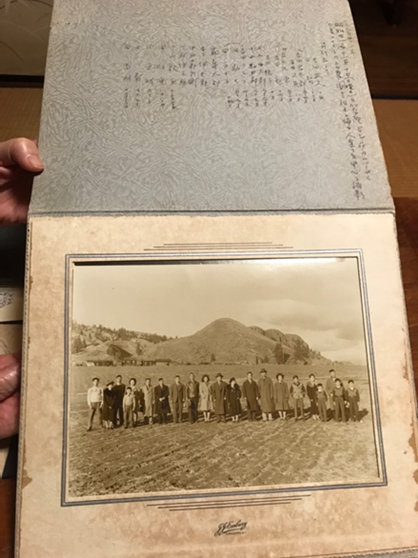Birth date: July 18th, 1950
Hometown: Mio, Mihama-cho, Hidaka, Wakayama
Filming date: November 9th, 2019
The location of filming: Canada Museum
Contents
Miyuki’s grandfather, Yoshitaro Ueyama, and his 3 brothers, Shuzo Nitta, Tomei Ueyama, and Einosuke Ueyama, and Shinzi(Miyuki’s husband)'s 3 sisters and a brother, Shigeko Ueyama, Akemi Mizuta, Harumi Okamoto and Shinichi Nakano had emigrated to Canada. Miyuki talked about her family and the reason why they had emigrated. She discussed the farm that Yoshitaro had run as a business. Yoshitaro had engaged in agriculture even though most people who had emigrated from Mio had engaged in salmon fishing. Shuzo, Tomei and Einosuke had engaged in fishing. The family's life was a remarkable story and how they had lived in Canada during WWII.
People migrated to Canada
・Yoshitaro Ueyama (Miyuki’s grandfather) ・Shuzo Nitta (Yoshitaro’s brother)
・Tomei Ueyama (Yoshitaro’s brother) ・Einosuke Ueyama (Yoshitaro’s brother)
・Shigeko Ueyama (Miyuki’s husband’s sister) ・Akemi Mizuta (Miyuki’s husband’s sister)
・Harumi Okamoto (Miyuki’s husband’s sister) ・Shinichi Nakano (Miyuki's husband's brother)
The photo introduced in the interview

Miyuki’s grandfather Yoshitaro Ueyama (eighth right) had engaged in agriculture though most people who had emigrated from Mio had engaged in fishing. Due to the outbreak of WWII, all persons of Japanese racial origin forced to displace from a 100-miles exclusion zone of the west coast of British Columbia. Yoshitaro ran his farm in Kamloops and because it was more than 100 miles away from the west coast of British Columbia and he was not interned into a camp. This photo was taken when his family and relatives visited his farm.
Source: photo provided by Miyuki Nakano
Businesses of Nikkeis
It is known that most Nikkei who emigrated from Mio had engaged in fishing, but they had also engaged in agriculture or mining when the period of fishing ended.(1) The emigration from Mio to Canada had started because Gihei Kuno had emigrated in 1888,(2) and Nikkei had engaged in other kinds of businesses except fishing.(3) Especially, there are 3480 Nikkeis had engaged in them as of 1900, and they were called “Hangyosya” in Japanese, which means people who engaged in both fishing and other businesses until the end of 1910.(3) In addition, the number of farmers was increased because Nikkei was forced to reduce the number of people who had fishing license among them by the government.(4)
Nikkeis’ farming ways in British Columbia
In British Columbia, where Kamloops is located, Nikkeis have been farming since the beginning of their immigration. Originally, it was easy for them to engage in agriculture as Japanese nationals in Canada, and they converted forests into farmland to develop their agricultural business.(5) At the lower Fraser River region including Kamloops, arable lands were spread out, and people cultivated vegetables, fruit trees, and did grazing.(6)(7)
Family Tree

【References】
₍₁₎蒲生正男(Masao Gamo)(1962). 「日系人の仕事」(「Nikkeijin-no-shigoto」), 『海を渡った日本の村』(『Umi-wo-watatta-nihon-no-mura』), 中央公論社(Chuokoronsha) , p.60-77
₍₂₎柳本文弥(Fumiya Yanagimoto)(2020). 『工野儀兵衛ものがたり』(『Kunogihei-monogatari』), NPO法人 日ノ岬・アメリカ村、カナダミュージアム(NPO hojin Hinomisaki・amerikamura、Kanadamyujiamu)
₍₃₎カナダ移住百年誌編集委員会(Kanada-iju-hyakunenshi-henshuiinkai)(1989). 「カナダの日系漁者」(「Kanada-no-nikkeigyosha」), 『カナダ移住百年誌』(『Kanada-iju-hyakunenshi』), 美浜町カナダ移住100周年記念事業実行委員会(Mihamacho-kanadaiju-100shunen-kinenjigyoji-kkoiinkai), p.99-116
₍₄₎“najc.ca 日系カナダ人の歴史(Nikkeikanadajin-no-rekishi)”
日系カナダ人の歴史(Nikkeikanadajin-no-rekishi)‐NAJC〈http://najc.ca/%E6%97%A5%E7%B3%BB%E3%82%AB%E3%83%8A%E3%83%80%E4%BA%BA%E3%81%AE%E6%AD%B4%E5%8F%B2/ 〉 (参照:2020-9-29)
₍₅₎カナダ移住百年誌編集委員会(Kanada-iju-hyakunenshi-henshuiinkai) (1989) .「太平洋戦争と日系人」(「Taiheiyosenso-to-nikkeijin」), 『カナダ移住百年誌』(『Kanada-iju-hyakunenshi』), 美浜町カナダ移住100周年記念事業実行委員会(Mihamacho-kanadaiju-100shunen-kinenjigyo-jikkoiinkai), p.158-168
₍₆₎(2012)“Taiken : Japanese Canadians Since 1877”, the Nikkei National Museum Center
₍₇₎田林明(Akira Tabayashi)、仁平尊明(Takaaki Nihei)、菊地俊夫(Toshio Kikuchi)、兼子純(Jun Kaneko)、トム ワルディチュック(Tom Waldichuk)(2016).「カナダ・ブリティッシュコロンビア州のローワーメインランド地域におけるサークル・ファーム・ツアーの意義(特集 カナダ・ブリティッシュコロンビア州における農村空間の商品化)」(「Kanada・buriteisshu-korombiashu-no-rowameinrandochiiki-ni-okeru-sakuru-fuamu-tsua-no-igi (Tokushu Kanada・buriteisshu-korombiashu-ni-okeru-nosonkukan-no-shohinka)」),『地理空間』(『Chirikukan』), 9-kan 1-gou, p.65-66
₍₈₎“~バンクーバー(Bankuba) (YVR)→カムループス(Kamurupusu) (YKA) 格安航空券・飛行機予約(Kakuyasukokuken・hikokiyoyaku)” エクスペディア(Ekusupedeia)〈 https://www.expedia.co.jp/lp/flights/yvr/yka/vancouver-to-kamloops 〉(参照:2020-9-29)
(9) Art Phyno (2018). “Internment, racism and baseball in southwestern Ontario: JapaenseCanadian farm labourers during World War II”, p.37-45
